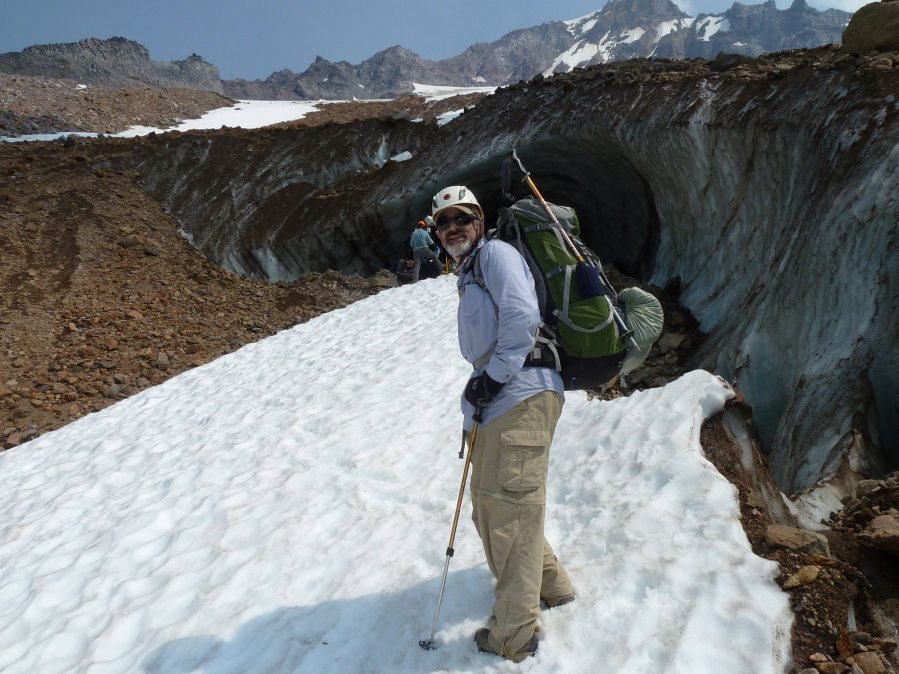High on Mount Erebus, Roberto Anitori climbed into an ice cave near the summit of the second-highest volcano in Antarctica.
Although he stood on a massive 12,447-foot mountain, his research involved collecting samples of some of the tiniest organisms. Wearing gloves to maintain the integrity of the sample, he used a sterile spatula to scoop soil from the cave floor. The cave void of natural light provided the extreme environment he was seeking.
The microbiologist who teaches at Clark College was searching for extremophiles, which he describes as organisms that can live in extreme environments: extreme cold, heat, acidic, alkaline, radioactive, high pressure, high saline and more.
Anitori said he tries to work in dark caves because most life on Earth depends either directly or indirectly on sunlight to grow. In contrast, he looks for life that finds a way to exist even in the harshest environments. Life forms in dark caves are analogous to ones at the bottom of the ocean, he said.
“In the last few decades, we’ve learned there’s life even a few miles down in the earth’s crust, a lot of it. It’s a substantial ecosystem,” Anitori said. “The interesting thing about ice caves — the ones that are dark — there are still living things there. Organisms in dark caves get their energy from chemicals, through rocks and gases, not sunlight.”
Put simply, Anitori traveled to Antarctica to study “rock-eating” microbes in caves on Mount Erebus. He wasn’t surprised to find organisms that obtain nutrients from rock.
“These microbes survive on nutrients within the very rock itself — for example, digesting manganese and iron the way other organisms digest biological material. Some can use volcanic gases to obtain energy for growth.”
Ice cave journey
As part of a team of glacial cave explorers, Anitori spent five weeks at McMurdo Station, a U.S. Antarctic research center about 850 miles north of the South Pole in November 2010. There are many ice caves on Mount Erebus, but Anitori’s team studied three: Harry’s Dream, Warren Cave and Hubert’s Nightmare. Anitori cultured bacteria from all three caves.
Before the team left McMurdo Station for their field trips up the mountain, they learned skills including crevasse rescue training, driving snowmobiles and sleeping all night inside a cozy, human-sized ice shelter.
The journey to the ice cave began with a helicopter ride to the 9,000-foot level of Mount Erebus. The team spent a few days acclimatizing at that elevation. Next, they rode snowmobiles up to the hut and tents that constituted the living quarters.
Cascade ice caves
Anitori is involved in a large group studying ice caves in the Cascades volcanoes. It fits in well with the Antarctic ice cave work he did earlier. To learn more, visit www.glaciercaveexplorers.org.
He was part of a team that explored two ice caves on Oregon’s Mount Hood in 2014: Snow Dragon and Pure Imagination. The caves at the bottom of the Sandy Glacier are at elevations from about 6,000 to 8,800 feet. Anitori collected soil samples from the caves and grew cultures of microorganisms back in the lab.
On Mount Hood, the entrance to the Snow Dragon ice cave has since collapsed. A new entrance developed farther up the mountain, but now the ice cave is that much shorter.
Studying ice caves will help scientists understand how they are melting, and how climate is affecting glaciers from the inside out.
The soil in the ice cave floor varies from cave to cave, he said. In Snow Dragon on Mount Hood, the soil was pebbly sand, but in the Antarctic caves, the soil was much finer.
His next ice cave research trip will be with a glacier exploration team in May 2017 at Mount St. Helens. Although his research is not a part of his work at Clark, he said he hopes to use data from his next research trip in his Small World antibiotic discovery course at Clark. The course exposes undergraduates to scientific research in seeking new antibiotics.
Anitori was born in Italy, but spent most of his life in Australia. He earned both bachelor’s and doctoral degrees in molecular biology and microbiology from the University of New South Wales in Sydney, Australia. He’s been teaching at Clark College since 2008.
He has researched extremophiles not only in Antarctica, but in other volcanoes, deep-sea vents, underground water tables, deserts and radioactive hot springs.
Anitori’s study of microbes living in soil in ice caves could play a role finding microbial life deep under the earth’s crust, far below the ocean or even in other bodies of the solar system.
He said that perhaps the kind of research he is conducting will pave the way in “searching for microbial life on the moons of Saturn or Jupiter or below the surface on Mars — where there’s ice.”




